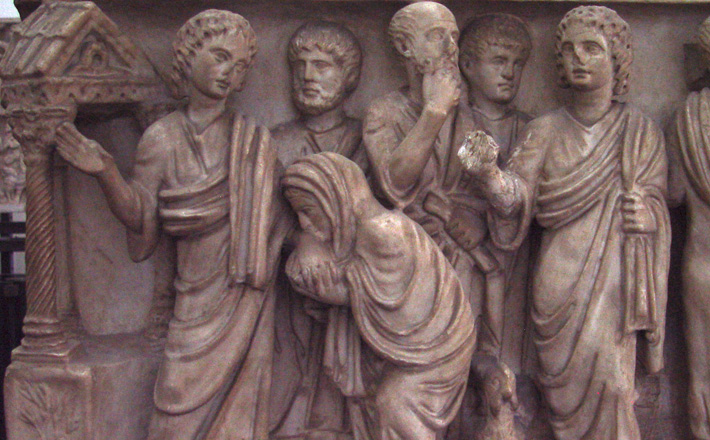Commentary on Luke 13:10-17
Two things are important to remember for framing this particular episode in Luke 13:10-17.
Since the beginning of Luke, the author of the Gospel has been trying to help us understand Jesus as coming from Jewish stock. Some may call Luke’s Gospel Gentile-friendly, but it clearly embraces his Jewishness. The Gospel writer celebrates it in the birth narratives of Luke 1-2 with the circumcision rite and Temple sacrifice and even has Jesus preach his first sermon in his home-town synagogue in Luke 4. Second, this Jesus has a conflicted relationship with his own Jewish heritage — a fact alluded to in the earliest chapters of Luke, but becoming especially clear when Jesus “sets his face to go to Jerusalem” at the beginning of his long cruciform journey in 9:51. The cross, therefore, casts its shadow even here in a scene of conflict in the synagogue
This, of course, helps make sense of our pericope’s setting. Luke 13:1 makes it clear that Jesus was teaching in the synagogue on the Sabbath. This Jesus is revealed here to be thoroughly Jewish. The appearance of a “woman with a spirit that had crippled her for eighteen years” sets the subsequent narrative conflict in motion. The wording in Greek shows that disease is understood as the product of spirits, in this case, a “spirit of weakness” (Luke 13:2). Some argue that our text is a miracle story; others, a pronouncement story built on the conflict between Jesus and his synagogue opponents. This particular text gives evidence of both kinds of story: it is a healing that leads to an important pronouncement. The purpose of understanding this, however, is that it might aid us in appreciating the uniqueness of the narrative itself: it is a miracle with something to say about God!
How do we know? Two features leap to mind. First, the miracle itself is hardly even described. Some miracles go to great lengths to show the run up and the denouement of the miraculous action. Here Luke rushes past the graphic physical description of the miracle to get to the conflict. The miracle serves just this purpose in our text. More importantly, however, the nature of that conflict is about whether doing a miracle constitutes work on the Sabbath. Luke’s narration, in sometimes subtle ways, undermines the notion with its taciturn approach to the miracle itself. The miracle is not marked by healing pyrotechnics: the only thing Jesus does physically is to lay hands on the woman. The power of the miracle is in what precedes and follows it: Jesus announces her freedom from the crippling spirit (“Woman, you are set free from your ailment.”) with a word and when she is healed, the healing happens in the form of the divine passive (“she stood up straight” actually reads in the Greek as she “was straightened up” — assuming God as agent). God not only “set free”, but “straightened” her in the synagogue on the Sabbath. All Jesus did was to lay on hands between the divine announcement and the divine action.
In some ways, this language of divine agency complicates the conflict. A synagogue leader in Luke 13:14 tries to shame Jesus indirectly by pointing out that the healing was work — something that could be done on any of the six days set aside for labor instead of the holy Sabbath. We would also be right to interpret Jesus’ response by the rabbinic argument of the lesser to the greater. Jesus responds, like his accuser, to the crowd by pointing out that any of them would take care of an animal needing help on the Sabbath — so how much more should they respond to a human being in need. All this kind of argument is well and good and undoubtedly very Jewish. But the synagogue leader and Jesus are actually saying more here. The synagogue leader uses the Greek verb dei to make his claim about the ought of work. Luke loves this verb in his narrative because it describes what it is necessary for Jesus to do as God’s agent. This is why Jesus’ response picks up on the synagogue leader’s claim. The ought here is not about a divine necessity to work on the other six days, but based on a divine necessity (dei) to have this woman be freed from bondage on the Sabbath (Luke 13:16). To make the point even clearer, he calls her what she really is a “daughter of Abraham.” Jesus here does not supersede Jewishness with his claims about the Sabbath, but rather intensifies their theological grounding in the necessity of God and God’s purposes to heal, liberate, and unbind.
As Luke is wont to do, the narrator points to the mystery of God’s action in this moment as a way of reframing Sabbath and relationships to all of the daughters of Abraham. There is no room here for Gentile gloating over some Jewish come-uppance. Instead, we are led to the threshold of celebrating and praising God along with the Jewish crowd. When God is up to something, prepare to be unbound: whether from confining diseases, or social norms about persons with disabilities, or even holy pieties. The fact that Jesus does this within the Jewish tradition and for a daughter of Abraham shows that God keeps showing up, drawing the circle just a little wider and unleashing a divine horizon that begets rejoicing over the loosing of every human bondage. We who gather around the Table should not be surprised. There, sometimes despite ourselves, we glimpse the great and glorious thing that God is doing, celebrate that space that is there for all, and give our thanks and praise. The God who shows up does not lead us out of our fellowship, but more deeply into it .. with others and with a Jesus who is committed with his very journey to the strange thing God deems necessary in Luke’s Jewish/Gentile Gospel.


August 21, 2016